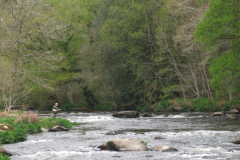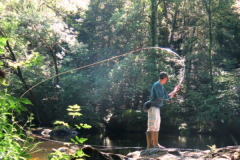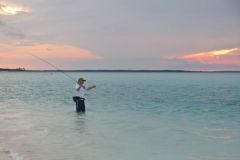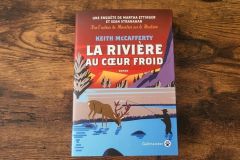The grasshopper
Orthopterans include a wide range of insects such as grasshoppers and crickets, as well as crickets, which are an important source of food for our trout. In summer, trout are eagerly awaiting their arrival, and a good imitation is sure to get them going. An exciting fishing experience that can pay off in spades!
Assembly sheet
- Hook TMC 200 R size 10 or 12.
- Nylon mounting wire, Uni-mono type or equivalent, and UTC 70 brown or black.
Using your nylon thread, come to the bend of the hook, then attach a strip of yellow foam 3 min wide and 2 cm long to the underside and another green strip of the same size to the top of the hook. Secure them by positioning them towards the rear.
Wrap your mono thread a few millimetres forward, then fold the foam over and under and secure with 2 or 3 turns. Spreading the foam, advance your mono thread along the shank, then repeat the operation, creating several small bulges of foam up to 3 or 4 minutes from the eyelet. Change mounting thread.
Make 2 pheasant legs by knotting 2 herls on each side, then cut one of the herls after the knot. Take a tuft of deer and attach it, choosing a length identical to that of the body. Make two turns without overtightening, then gradually tighten to secure. Trim off any excess. Take another well-filled tuft, having previously cut the tips of the hairs, and secure it with two loosely tightened turns, then gradually tighten, letting the deer turn around the hook, spread out and spread out. Repeat the operation, having firmly packed the first tuft backwards to compress the deer so that it is dense. Next, cut the deer into a ball shape to form the head (eyes can be made with a little varnish or felt, then UV glue). Final knot.
Tips and tricks
If you've never tried terrestrial fishing, I highly recommend it. Trout love it, and it's dynamic, explosive fishing. They sometimes take very discreetly, but often violently!
Fish mainly the edges, especially in areas close to grassy areas where these insects are found. Make bell-shaped casts so that the imitation falls naturally like a grasshopper that has jumped into the water. The sound of the impact on the water tends to attract them. Sometimes small animations using the tip to create ripples on the water can also trigger a strike.
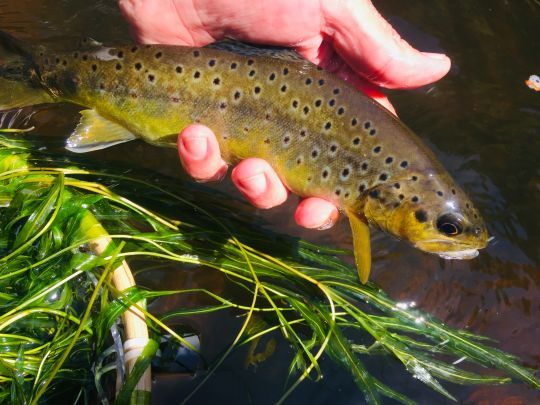
Ant
At the height of summer, and sometimes before, ant fallout can send trout into a frenzy, but it's not the only one. Grayling, whitefish and sometimes other fish, such as mullet, also benefit from this food bonanza. The river can simply boil! If you don't have an imitation, you're sure to be frustrated. You absolutely must have them in your boxes in all seasons, in different sizes (18 to 14) and colors (red, black, cream).
Simple, effective assembly.
Installation sheets
- Daiichi 1167 hook size 12 to 18.
- UTC 70 black mounting silk.
Cut a small strip of black or iridescent gray foam 2 to 3 minutes wide, then secure it a little lower than the bend. Block two peacock herls and roll them up to 2/3 of the shaft, then fold the foam over, stretching and blocking. Make a 2 mn long body of mounting silk. Attach another strip of foam, then a tip of white hackle on each side. Tie them backwards on each side so that they protrude a few millimetres from the butt of the fly.
Attach a short black hackle and wind it up to 2 min. from the eyelet, then after folding the hackle down, fold the band over it and secure. Make a small head and final knot.
Tips and tricks
This model floats low on the water, but thanks to the foam it won't sink. You can mount it with a small parachute or orange/pink tag on the back at the level of the second foam ball to increase its visibility. However, the white wings provide good visibility. The important thing for ant fishing is to have the right size and color.
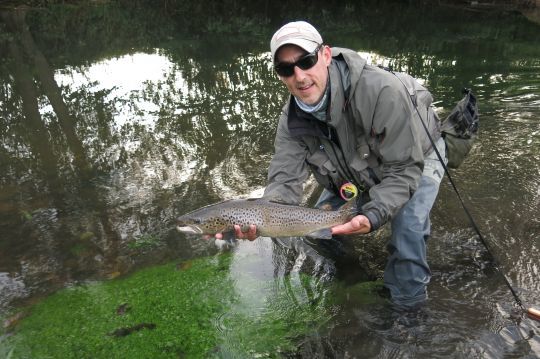
Rubber leg "bug
This fly is a must-have when looking for big sea trout in Argentina. But you must try this type of pattern on our sea-trout rivers, especially in Normandy. I've done it on the Touques, with great success. You have to offer these sea trout flies that are different from what they see, to surprise them. Plastic legs emit numerous vibrations that interest our migratory fish.
Installation sheets
- Kamasan hook B170 or B175 size 12.
- UTC 70 mounting wire, black.
Behind the eyelet, attach diabolo eyes (weight as desired) in 8-shape, having first added a small drop of cyano glue.
Two pairs of white or yellow rubber legs are attached to half the shaft.
Come to the bend and attach black squirrel dubbing or, in the case of this one, a combination of squirrel and multicolored micro-flash (red, blue, green) to its crimped thread. Wrap the dubbing around the body and legs, up to the eyes.
Final knot.
Tips and tricks
Available in different sizes (12 to 6), body colors (black, chartreuse in particular) and leg colors (yellow, chartreuse, white).
Let the fly drift in the current, or animate it with short pulls and releases (twitch), or short, dry strips to bring it to the surface. This brings the fly to life and makes the legs vibrate. It can be used as a drowned fly for fishing ¾ downstream, or as a streamer (upstream casting possible to get closer to the bottom) by letting it dive before animating it.
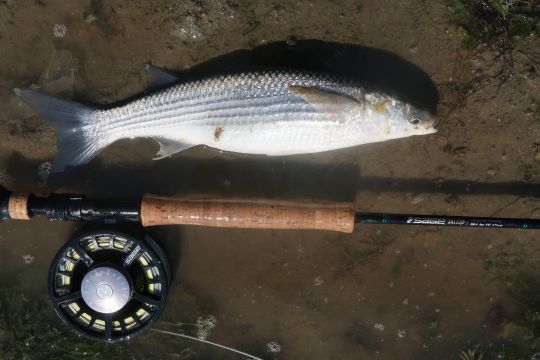
Spectra Shrimp
A design by Welsh angler Collin MacLeod that works very well on mullet. This fly is very catchy on mullets that come to the mudflats at high tide to feed on small marine crustaceans. Very similar or even identical to a gammare. Works well in estuaries, but needs testing elsewhere. This fly enabled me to catch golden mullets and lipus mullets.
Assembly sheet
- Hook Kamasan B 100 size 12
- Brown or olive UTC mounting wire.
Attach a few peacock neck fibers just after the bend so that the fibers go down.
Attach the flat gold tinsel and keep it on standby. Then attach Hends Shell Back pearl brown or a strand of Lateral scale pearl (in my case).
Put pitch on your mounting silk, then Hends Spectra Dub dark brown peacok (N°335). Create a slightly bushy body. Secure the shell back or lateral scale behind the eyelet, then hoop with gold tinsel. Make a small head and final knot.
Cover the back with UV thin resin and set. Stuff the dubbing with a needle to simulate legs.
Tips and tricks
I regularly use two models and very often on a train of flies. The spectra shrimp in tippet (heavier) and the bach mullet in gallows (to be seen soon). At the start of the run, when the mullets are rising on the mudflats, let the current do its work or animate the flies very close to the bottom if necessary. Short, quick strips can also attract attention and trigger the fly. Don't hesitate to cast often in front of a group of fish.
Nayat Surf candy (second fly in the photo)
This renowned fly has proven its worth. It is an imitation of a small fry or small forage fish, depending on the size chosen. This is the fly to have when you're looking for sea bass on the coast, particularly in Brittany but all over Europe. Easy to cast and very imitative, bass are fond of it. A simple fly to assemble and very catchy.
Assembly sheet
- Tiemco hook 811S size 4
- Nanosilk mounting silk 12/0-50 D olive
Come to the bend and attach 2 strands of olive flashabou. Wrap them over the mounting line, going back and forth 1 time.
Come within 3 or 4 minutes of the carnation, then take a small tuft of white nayat. Personally, I divide it in two, then turn one part over to put it on its head. Then I mix to get a gradient of size on each side.
Fix one part of the tuft under the hook and fold the second part over the top of the shank.
Take Wing 'n flash pearl or Angel hair and attach a few strands to the top.
Take a tuft of olive nayat the same size as the white nayat and attach it so that the tail is graded and the same length as before.
Then attach a piece of olive flashabou to each side of the fly where the white nayat and olive meet. This simulates the lateral line.
Form a small head of mounting silk and cover with a strand of olive flashabou which you will wrap around it. Final knot.
Place a 5-minute 3D eye on each side.
Take thin loon UV resin or equivalent, place between the eyes and set.
Then take the two tufts of nayat and stretch them well backwards to stretch the nayat and give it the desired shape. Apply the resin, placing a drop on each side and using a needle, spread the resin into the hairs, then set. Repeat the operation in thin layers to obtain a smooth oval body along the entire length of the shank (starting from the eyelet) and extending a few millimetres beyond the hook (this limits tangling). Repeat this step as many times as necessary. Freeze. Fly complete.
Tips and tricks
I tie these flies in different colors to imitate different prey that bass like. My favorite colors are olive/white, gray/white, pearl/white, blue/white and all-white.
In strong currents, let the fly drift inert, then take a few pulls from time to time to imitate a dying prey.
In slower sectors, animate with long pulls or fast stop-and-go.
You can mount two of them on your leader. One as a stem and the other as a tippet to imitate a small bank. In small sizes (6 to 8), this fly can be used as a teaser.
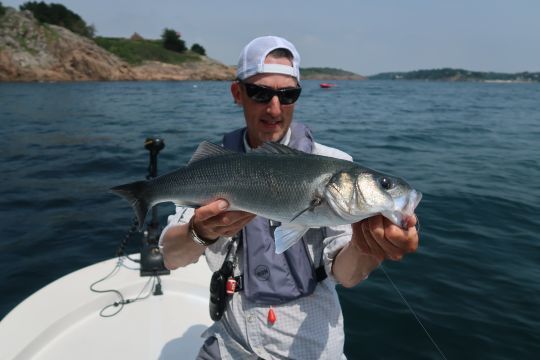
Crease Fly (first fly in photo)
This fly, shown to me by Hernan Tula, a professional fly tyer from Argentina, is fairly simple to make, even if it does require a little time and practice.
An interesting version for the fly fisher as it is very light and easy to cast despite its size. It makes very attractive little pops, although more discreet than a popper, which is of interest to both freshwater and marine predators.
Assembly sheet
- Mustad hook 34007 size 2/0 to 4/0.
- White Veevus G02 100D mounting silk to line the hook.
In a 2-minute foam tray, cut a shape as shown in the photo. On both sides, cut the slices on a bevel. They will fit together.
On your hook, come with the line, covering the shank well to ensure good adhesion of the glue between the hook and the foam. Come to the bend and attach a tuft of synthetic fiber such as EP, Dickers (put Wing'n flash between two tufts to create reflections) or in this case Steve Farrar SF Blend UV White (already embellished with flash) 7/8 centimeters long. 1.5 times body length.
Turn the fly over in your vice or make ½ turn on a rotary vice, and come to present the foam form by just biting both sides of the form without protruding too far from the hook this to keep clearance and ensure good hook penetration.
Apply cyano glue to the entire shaft, then place the shape on the right side so that the bevelled sides come together, pressing well between your fingers to ensure a firm hold. You can then reattach the shape by applying a small drop of cyano with a needle to each spot where the bond is unsatisfactory. On some foams, you can use a lighter to quickly burn the foam together.
It's possible to leave the "mouth" hollow, but I prefer to cut a small shape to match the hole between the eyelet and the foam. Position the small shape and apply a little cyano glue with a needle.
Glue flat or 3D eyes. Color the fly as you like. Glitter varnish, for example.
Take an Epoxy kit and prepare the required quantity. Using your needle or a toothpick, apply a thin layer all over without any unevenness. Allow to dry for 5 minutes, then leave untouched for at least 12 to 24 hours.
Tips and tricks
Can be mounted in different sizes and colors to suit the prey of the moment.
They can be easily colored in with indelible markers, representing a multitude of prey.
A thin film called Gummi Flash Foil can be applied to the foam form before mounting. The result is beautiful reflections!
Perch, asp, sea bass and, I have no doubt, black bass can all be caught with this model.



